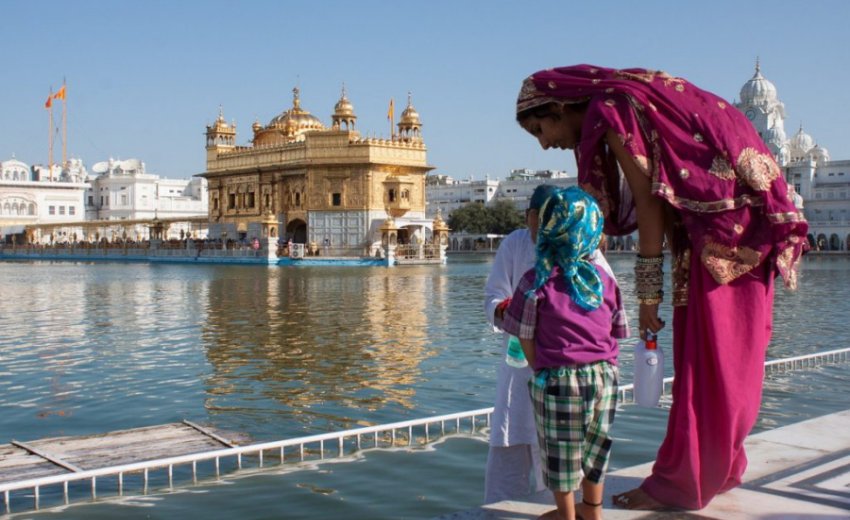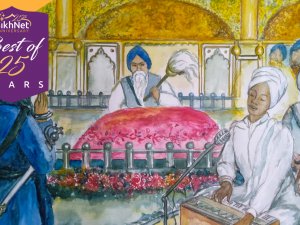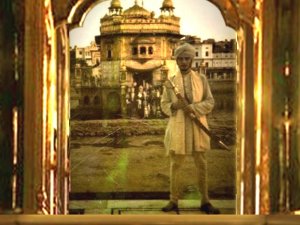Read Part I here
Read Part II here
Read Part III here
Read Part IV here
Read Part V here
This paper is based on the observation that the transmission of meditative awareness is no longer at the centre of Sikh practice. Numerous apparent changes in the historic vitality and integrity of the Sikh Panth may be traced to this development. In this section, we will briefly examine changes that have occurred in five aspects of Sikh culture: spiritual training and education, practice, culture, self-concept, sovereignty, and outreach.
5.1 Spiritual Training and Education
As we have previously seen, during the formative years of Sikh dharma, its leadership frequently emanated from its youth. From these examples, we can assume that spiritual training and education began very early in life.
Today however, Gurdwaras are typically administered by senior members of the community with minimal concern for the spiritual needs of children and youth. The ignorance of the soulful potentialities of the young and the neglect of their spiritual training may be partially attributed to the dominant secular educational model. Rather than focussing on character development, secular schooling gives training in skills designed to give a person an edge in an increasingly competitive, technology-driven world. As members of a religious minority and often as immigrants, Sikhs are particularly vulnerable to pressures to compete and be materially successful.
Several writers have described the shortcomings of Gurdwaras in passing the Sikh spiritual tradition to new generations. Most of these studies focus on emigrant communities in the West, but the dynamic is practically identical in Punjab. A common issue is a confusion among parents between those values and practices which are religious and those which are merely cultural. One generally shared frustration among youngsters is that they feel they cannot both be Sikh and Westernized. Most Gurdwaras feed this apparent dissonance by offering children Punjabi classes, but no form of spiritual training, as though by merely learning to read and write in their mother tongue these children will grow to be fully realized Sikhs of the Guru.
5.2 Practice
A culture of deep meditation and service filled the early Sikh community. In this spiritual environment, saints were created, Gurbani was written, the Adi Granth was compiled, Miri Piri was founded, and Khalsa was born. Sikh culture was graced with simplicity and a lack of pretentious formality.
By comparison, rituals and readings are now the main occupation of the Granthis (priests), Paathis readers, and Ragis (musicians) in most Sikh temples. The rituals and conventions of present day Sikh culture take up several pages of instructions on the SGPC website. The culture of Gurdwaras today does not foster self-experience, self-empowerment or community development. In this presentation, we will call this trend the ‘brahminization’ of Sikh practice.
In recent times, it may be that the man who most truthfully shared the living, informal spirit of Guru Nanak was Siri Singh Sahib Harbhajan Singh Khalsa. In his thirty-six years of active teaching, he shared a consistent message that God is near at hand and accessible through meditation and good actions. Siri Singh Sahib also warned of the corrupting influence of ritualism. The following is a quote from a lecture.
Look at that relationship! Sikh religion has to be understood – by Sikhs also. Sikh religion has become the biggest pivot of Brahmanism. It has lost its track. It has gone astray. Nothing is understood. (Siri Singh Sahib, June 6, 1989)
With the increasing wealth of the community, Gurdwaras continue to be built, bigger and more ostentatious, and readings continue to be commissioned. Seniors rule the holy places as presidents and committees with no thought for the next hundred years. Children and youth are bored with Gurdwara and seek their destiny elsewhere.
5.3 Culture
In its early centuries, the sublime awareness communicated by Gurbani was readily accessible because of the culture of meditation and service at the heart of the Sikh community. Practical role models and encouragement in the practice of meditation abounded for young and old.
Gurbani is today widely interpreted as theology and taught in the abstract. Translations usually centre around a distant, male God. The papers presented at a conference on Mool Mantra organized by the Department of Guru Nanak Studies at Guru Nanak Dev University in 1973, and subsequently published as Sikh Concept of the Divine illustrates this well. These papers do not address the personal realization of Mool Mantra, but contend only with conceptual and linguistic interpretations. The following depiction of Mool Mantra serves as an example of this thinking. In this paper, we will use the term ‘theologization’ to describe the transition from a culture of experience to one focused on theology.
There is but one God. True is His Name, creative His personality and immortal His form. He is without fear, sans enmity, unborn and self-illumined. By the Guru’s grace (He is obtained). (Manmohan Singh. 1962. translator, Siri Guru Granth Sahib (English & Punjabi translation), Volume 1, Amritsar: Shiromani Gurdwara Parbandhak Committee, 1)
Giving Gurbani, and especially the Mool Mantra, an abstract interpretation and treating it as though it were a matter understandable only by scholars, creates a divide between individual Sikhs and their Guru. If academics who should know better make Gurbani impersonal and hard to understand for adults, this is especially the case among young people who are usually mere afterthoughts in Gurdwara culture.
5.4 Self-concept
Originally, a Sikh of the Guru was defined by their soulful activities, specifically their meditation in the pre-dawn hours and throughout the day . The classical definition of a Sikh is given by Guru Ram Das:
And contemplate God’s Name. In the early hours of the morning, they should endeavour to bathe
In the ambrosial pool while repeating the Name taught by the Guru. In this way, they truly erase their sins.
Then, with the arrival of dawn, they should sing Gurbani and reflect on God’s Name all through the day.
One who with each breath and morsel remembers my God,
God is a beloved disciple of the Guru. (Siri Guru Granth Sahib, 305-306)
ਮਃ ੪ ॥
मः ४ ॥
Mėhlā 4.
ਗੁਰ ਸਤਿਗੁਰ ਕਾ ਜੋ ਸਿਖੁ ਅਖਾਏ ਸੁ ਭਲਕੇ ਉਠਿ ਹਰਿ ਨਾਮੁ ਧਿਆਵੈ ॥
गुर सतिगुर का जो सिखु अखाए सु भलके उठि हरि नामु धिआवै ॥
Gur saṯgur kā jo sikẖ akẖā▫e so bẖalke uṯẖ har nām ḏẖi▫āvai.
ਉਦਮੁ ਕਰੇ ਭਲਕੇ ਪਰਭਾਤੀ ਇਸਨਾਨੁ ਕਰੇ ਅੰਮ੍ਰਿਤ ਸਰਿ ਨਾਵੈ ॥
उदमु करे भलके परभाती इसनानु करे अम्रित सरि नावै ॥
Uḏam kare bẖalke parbẖāṯī isnān kare amriṯ sar nāvai.
ਉਪਦੇਸਿ ਗੁਰੂ ਹਰਿ ਹਰਿ ਜਪੁ ਜਾਪੈ ਸਭਿ ਕਿਲਵਿਖ ਪਾਪ ਦੋਖ ਲਹਿ ਜਾਵੈ ॥
उपदेसि गुरू हरि हरि जपु जापै सभि किलविख पाप दोख लहि जावै ॥
Upḏes gurū har har jap jāpai sabẖ kilvikẖ pāp ḏokẖ lėh jāvai.
ਫਿਰਿ ਚੜੈ ਦਿਵਸੁ ਗੁਰਬਾਣੀ ਗਾਵੈ ਬਹਦਿਆ ਉਠਦਿਆ ਹਰਿ ਨਾਮੁ ਧਿਆਵੈ ॥
फिरि चड़ै दिवसु गुरबाणी गावै बहदिआ उठदिआ हरि नामु धिआवै ॥
Fir cẖaṛai ḏivas gurbāṇī gāvai bahḏi▫ā uṯẖ▫ḏi▫ā har nām ḏẖi▫āvai.
ਜੋ ਸਾਸਿ ਗਿਰਾਸਿ ਧਿਆਏ ਮੇਰਾ ਹਰਿ ਹਰਿ ਸੋ ਗੁਰਸਿਖੁ ਗੁਰੂ ਮਨਿ ਭਾਵੈ ॥
जो सासि गिरासि धिआए मेरा हरि हरि सो गुरसिखु गुरू मनि भावै ॥
Jo sās girās ḏẖi▫ā▫e merā har har so gursikẖ gurū man bẖāvai.
Today, the terms ‘Punjabi’ and ‘Sikh’ are often confused. Movements in both the US and UK are presently engaged in efforts to have Sikhs recognized as a distinct ethnic (not religious) group in future national censuses. Punjab is the birthplace of Guru Nanak, but a true Sikh is someone who practices a daily discipline and lives the lifestyle taught by the Guru. Eating, speaking and dressing Punjabi does not make one a Sikh. We will use the term ‘ethnicization’ here to describe attitudes and behaviours that support the reduction of the Sikh community from a spiritual movement to a cultural group.
5.5 Sovereignty
In its early days, the Sikh Panth conducted itself as a sovereign spiritual nation. This is no longer the case and may be attributed to two plausible causes: inherited psychological trauma and the brainwashing incurred when Sikhs lived under British rule.
Psychological trauma impacts self-esteem and the capacity for self-regulation, and can be transmitted through generations. Recovery from the accumulated trauma of 18th century holocausts, 19th century colonization, and the horrors of 1947 and 1984 may require many years of self-reflection and healing. Until this healing has occurred, unconscious trauma may play a role in the day to day life of the Panth.
Many Sikhs today take perverse pride in what may be termed ‘badges of bondage’ acquired during the period of British rule. Having finally inflicted defeat on the Sikh nation in 1849, the British were expert at rewarding their helpers with land, status and lucrative employment, and at destroying the lives of those who opposed them. Bhai Jawahar Singh, son of the legendary general of the Sikh Raj, Hari Singh Nalwa, had his lands taken away and was refused even a pension to live on, while the traitor Teja Singh was given a landed estate with a handsome income for the rest of his life. The Namdharis were the first to boycott British education, fashion, justice, and its postal service. Its leaders were made to suffer for their choices. The Akalis continued the effort for self-rule, but the British did their best to soften their opposition with perks and various kinds of corruption. Before long, they had many lassi-drinking Punjabis drinking tea, rolling their beards up into little nets, fighting their wars, and adopting English tastes and values. Today’s addiction to black tea, the habit of beard-tying or being ‘clean-shaven,’ reliance on Western justice, a preference for Western fashions, absorption in consumerism and uncritical acceptance of corporate culture go largely unchallenged in Sikh culture, having long ago been abjectly absorbed and accepted into Sikh thinking.
5.6 Outreach
People say that Guru Nanak taught and travelled far and wide, reaching Mecca in the west, Tibet in the north, Assam in the east, and Sri Lanka to the south. The following Gurus also went on teaching tours to spread the faith.
While there are several Sikh missionary colleges in Punjab and Delhi today, their graduates are for internal consumption only, serving only existing Punjabi and Hindi speaking congregations. These colleges do not graduate true missionaries.
Such effective outreach as exists is independent of any religious body. Khalsa Aid, based in England, bravely provides vital supplies and disaster relief in Iraq, Mali, Greece, even flood-stricken England. Sikh yoga and meditation organizations originating in Siri Singh Sahib’s missionary efforts in the US also bring the Shabad Guru and aspects of Sikh lifestyle to dozens of countries on six continents. Both groups, however, are limited in their support from the larger Sikh community.
In the golden years of Sikh spirituality, the Sikh community was awake and alive to the real challenges of that time. The Guru and his followers opposed tyranny, bigotry, and ritualistic religion. They also meditated, worked honestly, and shared their earnings with the needy. Sikhs were known and appreciated for their courage and integrity. Today, the traditional prayer sarbat da bhalla – may the good of all be served – is more often understood as ‘may my good be served.’ This change in attitude naturally affects the reality of Sikh dharma. It also raises questions for Sikh youth finding their spiritual identity.






